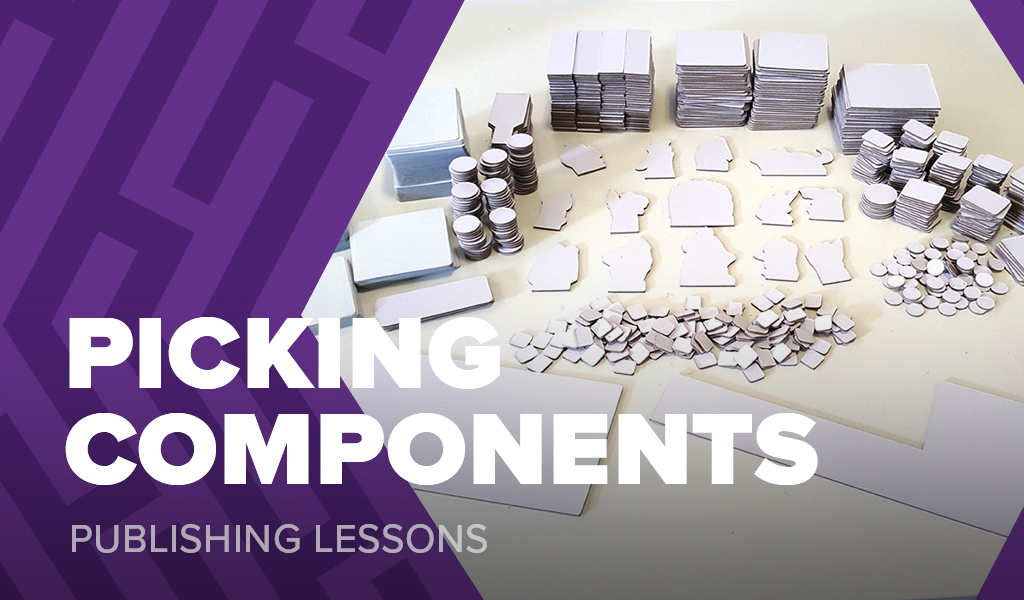Choosing components for your game

There comes a time in every creators first project where they have to put together a specification document for manufacturers to quote on. For seasoned veterans this is a fairly easy task as you quickly become familiar with the available options, but if you’re getting your first quotes it can be challenging to know what to ask for.
Quick Tip
When I first started, I asked manufacturers if they had sample kits, but I also asked them to tell me a few games they had recently worked on. This allowed me to buy copies of those games (or see them in a board game café) and then request my game used similar materials.
The risk
It is really important you know what you are asking for as many manufacturers will want to give you the cheapest quote possible in order to win your business. This means if you ask for a quote on a box, they may use cheaper/thinner materials than you would like in order to keep the price down.
If you use a recommended manufacturer this will be less of an issue, but you do still need to be aware of it. There’s nothing worse than finally getting your game and being unhappy with the quality of components.
My standard components
Playing cards
For playing cards I tend to use 310gsm Black Core Paper with a playing card varnish and linen finish. These are really good cards to include in any game, although you can bring the cost down by skipping the linen finish if you need to.
The size of the cards can vary depending on the purpose but for standard cards I use 63x88mm cards.
Punchboards
For punchboards the thickness is very important in terms of the feel of the game, but it can also greatly impact the cost and weight of the game so you should really think about what works for you.
I find 1.5mm greyboard is great for most things and it’s my go to thickness. I’ll sometimes use 2mm greyboard for pieces that really need extra thickness for gameplay reasons.
When asking for quotes I’ll start with 250gsm CCNB on 1.5mm greyboard.
The dimensions of the punchboards are completely dependant on the number of tokens and box size.
Boxes
The materials used for a box will vary a little depending on the size of the game box, if you’re making a 4x4x2 inch small box game you may want to use thinner materials than you would for a 16x12x8 inch game.
157gsm paper on 1.5mm greyboard with a Matt finish works well for boxes up to 12x12x3 inches.
I’ve typically opted for thicker boxes as I feel more thickness offers an extra level of quality to the game that many people notice when picking up the box, but this can be expensive and I would say it is a luxury.
For my own games I have used both 2mm and 3mm greyboard.
Rulebooks
I am a big fan of keeping as close to standard size paper as possible for rulebooks, meaning A4 in the UK or I believe the US refer to it as letter size.
While some games will use square rulebooks to take advantage of the space in their box, I’ve noticed they are less practical to hold and take up more space on the table. This is relevant as a lot of people will have the rulebook out on the table during their first game, so the more space the rulebook requires the less practical it is.
I tend to aim for 220x280mm paper in multiples of 4, meaning 4, 8, 12, 16, 20 pages as it helps optimise the process.
Material wise I recommend 128gsm C2S paper with an aqueous varnish.
Hopefully this should help you with putting together your first quote, but if you have any other components you’re not sure about then feel free to ask in the comments.
Do you have any go to materials you use in your games that differ from those I’ve mentioned above?
Frank West
Frank West is a gamer and designer based in Bristol, UK. He published his first board game, The City of Kings, in 2018 and now works on other games and organising events in the local area. His goal? To design and publish games focusing on immersive themes, fun mechanics and beautiful components. If you have any questions or would just like a chat, feel free to get in touch at any time!


8 comments
Josh W
28th February 2023 at 1:14 pm
What about meeples? Any standards you recommend there? I know the marrrials can easily vary, but like standard wood, cubes or custom cut, thickness, etc?
Frank West
28th February 2023 at 1:45 pm
Great question Josh!
For standard wooden pieces I’ve found the following works well:
– Cubes at 8 x 8 x 8mm
– Discs at 4mm thick with a 15mm diameter
Although it’s easy enough to change the dimensions if needed.
For custom shapes, I’ve found a thickness of 7mm works well for pieces up to 25x25mm, and a thickness of 9mm works well for pieces larger than that.
Material wise I’ve noticed most manufacturers have their own standard materials for wooden pieces so there’s no need to specify the wood unless you need something specific.
I hope that helps!
Cristine Daniel
15th October 2023 at 7:14 pm
Hi Frank ,
Thank you for this post. It was really informative. I’m interested in learning how to get a quote on manufacturing a game with components. Any ideas would be greatly appreciated.
Cristine
Frank West
16th October 2023 at 10:33 am
I’m glad to hear it was helpful!
You can find my recommended manufacturers here: https://thecityofkings.com/news/board-game-manufacturers-how-to-choose-one/
I would suggest emailing a few of them and saying you would like to make a game and get a quote. Asking what they need from you in order to do so.
They should be able to assist and get the process going.
I hope this helps!
Rafael
4th January 2024 at 4:43 pm
Your posts are quick and to the point, a real gem to those of us that have no or little experience in boardgame design and publishing. Thank you for that.
I wonder what you would recommend as materials for hexagon tiles in a tactical game with a medieval theme. Any specific type of wood? Or resin like Azul?
Frank West
11th January 2024 at 10:37 am
It’s my pleasure Rafael, I am glad the articles have been helpful.
For your hexagon tiles, cost is going to play a big factor as is the amount of information you need displayed on the tile. If they are a simple pattern or colour, or whether they have a lot of detail on them will likely play into the decision. Depending on size and quantity, you may find cardboard to be the only affordable route.
If the detail is low, then wood may be a good option and you would want to talk through the specific material, sizes, and print options with a factory.
If the detail is higher and you want a more deluxe option, then acrylic may be a good option for you. If you haven’t looked at them, I would recommend browsing gamefound for “Castles Of Burgundy: Special Edition” – They had a deluxe option containing acrylic hex tiles. However, keep in mind they charged $35 just for those tiles, meaning the cost is going to be high.
I hope this helps!
Stephanie England
25th July 2024 at 4:45 pm
Good Morning Mr. Frank,
I am a 5th/6th grade teacher and thank you Google search for helping me find your page! My students will be learning about the American Revolution this year, and the final product will be for the students to take the things they have learned and create an engaging game (may just be a plan for some because of time). What suggestions/ do you have suggestions for me as I create a list of non-negotiable things that all games must include? Is there anything else you think would be helpful for me to have in mind as I try this new thing? Would you be willing to meet with us via meets or zoom for my kids to ask design questions? Thank you SO much for reading this and your consideration!
Frank West
26th July 2024 at 10:33 am
Hi Stephanie, thank you for your message, this sounds like a great thing to be doing. My approach to this would be to keep the scope very small, as creating a full game can be very time consuming. There are 2 approaches I would consider, depending on how you want the lesson to go.
A) You could focus it more around idea of games and what cool stuff a game could do. For example, “what would you like to do in the game”, “what would be a good goal of the game”, “what would the story of the game be”, perhaps being restricted to something within your theme of the American Revolution.
B) You could set a smaller design task so they could create something specific. For example, in the game Chutes and Ladders, you roll a dice and move along the spaces. A fun design task is to think about different ways you could move, if you took the dice away, what could you replace it with? Could it be cards in some way, discussion, questions with rewards and so on. This allows people to create something and play it without having to make a full game.
Of course, you will know better than I what the class will be capable of.
I would be happy to try and organise a Zoom call if it would be good, but please do keep in mind I am based in the UK so the time zone may be a problem. My email is on the contact page if you want to try and arrange something.
I hope the class goes well and thanks for helping introduce more people to board games!